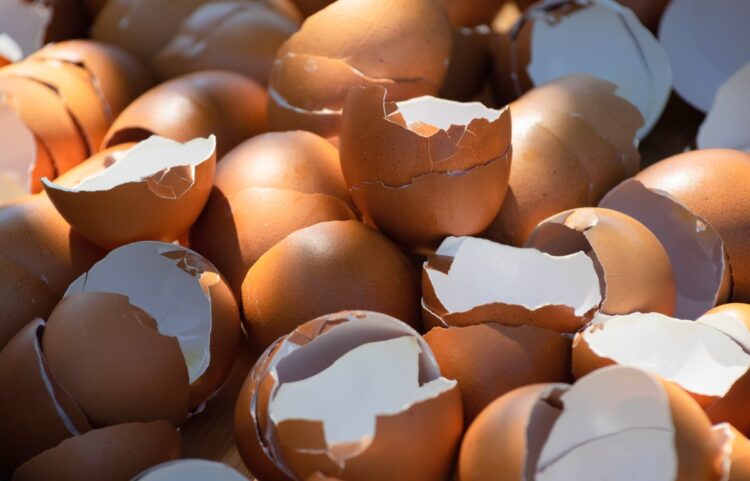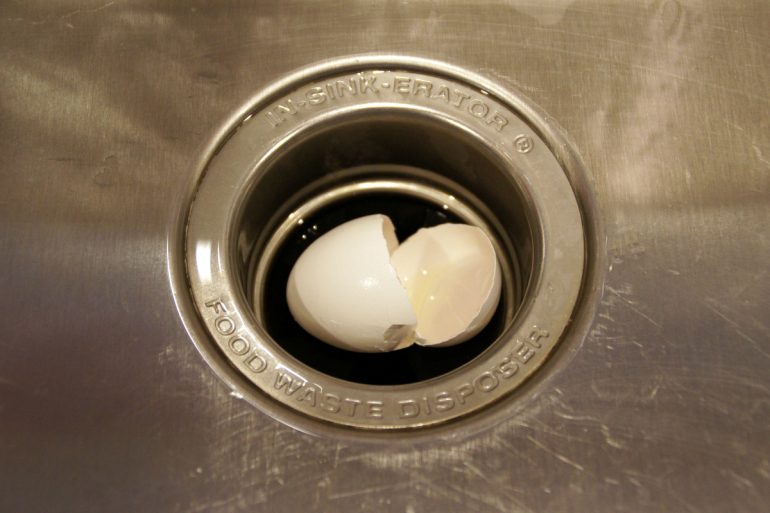It’s a point of contention in many households: Can you, or can you not, run eggshells through the kitchen sink’s garbage disposal?
Garbage disposals — known in the industry as “food waste disposers” — were invented in 1927, and first became popular in the US during the 1950s. Though nearly half the homes in America use disposals, not all of us agree on how to use them.
Several decades ago, when sink disposals were still somewhat newfangled kitchen appliances — right up there with trash compactors and microwaves — many Gen Xers got in the habit of throwing everything from orange peels to eggshells down into the hole in the sink with the scary grinder.
Thirty-plus years on, is that still good advice?
Can you put eggshells down the garbage disposal?
There are two schools of thought…
Yes, go for it: That’s what the disposal is for, after all! Some people even say that eggshells are actually beneficial to the disposer, because the ground particles can scrape off caked-on gunk in the machine’s various crevasses, thereby keeping your drain smelling better.
InSinkErator even says of putting small hard materials down the drain, “A scouring action is created by the particles inside the grind chamber.”
Don’t do it: Putting eggshells down the disposal will create “sand-like particles” and/or stick to the pipe walls, slowing the drain and possibly causing a clog.
Says one Lilyvolt editor, “I used to put eggshells down the disposal, but my friend whose dad is a plumber says people who do that keep him in business. It can result in you needing to dig up the yard to get to the pipes, because the shells get compacted with fat and create huge blockages.”

No need to walk on eggshells
It turns out that there’s a good reason for people to be divided on the issue: even the experts and manufacturers can’t reach a consensus.
Yes: KitchenAid and Whirlpool — who seem to use the same exact user manual for their standard “food waste disposer” models — say that their units are “designed to dispose of food wastes including bones, fruit and vegetable wastes, pits, egg shells and coffee grounds.” (They do, however, caution that if you have a septic tank, you should limit the amount of eggshell that you grind.)
Yes, in moderation: InSinkErator’s garbage disposal instruction manual specifically states, “Don’t grind large amounts of egg shells or fibrous materials like corn husks, artichokes, etc, to avoid possible drain blockage.”
Undecided: GE and Maytag abstained by not specifically mentioning egg shells in their instruction manuals.
No: Several city wastewater associations — presumably the ones who frequently have to deal with the issues created by eggshells — seem to issue the same recommendations that say, “Do not put animal fats & bones, grease, coffee grounds, citrus & melon rinds, corn cobs, eggshells, down the sink,” adding, “Garbage disposal use should be limited to waste that cannot be scooped out and thrown in the trash.”
However, saying no citrus rinds flies directly in the face of advice issued by several manufacturers, who often recommend running orange and lemon peels down the disposal to help deodorize and freshen the drain.
Our verdict: Play it safe. If there’s any doubt, toss your eggshells in the trash — or, better yet, compost them. (Another idea is shown below: Use them like mini-pots to start seedlings.)
If your sink’s garbage disposal has been going for 10 years or more, it may not be as strong as it once was, and you might not want to stress it with eggshells. Plus, as time goes by, there’s likely to be more build-up in the pipes, creating a greater risk of a clog.

Keeping the works working, egg shells or not
No matter what you choose to do about egg shells, there’s still one rule everyone agrees on: Every time you put something down your garbage disposal, be sure to run plenty of cold water before, during and after you flip the switch (for an extra 10-15 seconds) to flush out the pipe and avoid clogs.
Finally — and regardless of whether you just installed a new garbage disposal or it’s one that’s been in the house since it was built — we’ve learned the hard way that it’s always smart to keep an inexpensive jam-busting wrench on hand. They’re surprisingly effective for quick repairs, and are super-simple to use.








